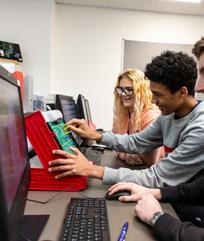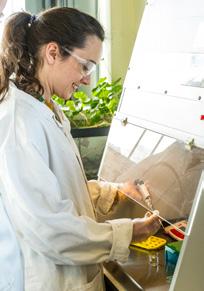
14 minute read
Transition to Degree-Level Learning
Your Tutor Your Tutor is your main source of academic support and guidance, and you will meet them at an early stage of your induction programme.
Your Tutor is responsible for:
• Monitoring your academic progress • Introducing you to College services, facilities and regulations • Monitoring sickness and absence • Helping you to develop your learning skills • Meeting with you on a regular basis to set and review targets • Facilitating enquiries about careers and further study, and referring you to our specialist services where necessary • Providing a first point of contact for personal or academic concerns
You are expected to:
• Take responsibility for your own learning • Seek advice or help if you need it • Attend any scheduled meetings with your Tutor • Notify your Tutor if you are going to be absent


Libraries, Learning Resources & IT The Libraries are the main study centres for students, with books, journals, e-books and specialist online information services.
All our e-books and e-resources can be accessed either at College or at home via Moodle, our virtual learning environment. You can use all of these services just by using your College login details, you can register once you are on the sites to receive a more personalised service. To make sure you find quality information, we have a range of online resources with access to thousands of academic journals and many trusted organisations, websites and services. Library staff are available to give help and advice on finding all the information and services that you need, and there are also many helpsheets on the Moodle Learning Resources page. For help with study skills, please ask Library staff for details. Your College ID card needs to be shown each time you come in to the Library and it is also your library card. Please note we charge fines for overdue items. We provide silent and quiet study areas, as well as group study facilities, to cater for different learning preferences. Computer facilities (PCs, netbooks and iMacs) are provided to assist you with your College work. We advise you to save your work on your personal College Network Drive and keep additional copies on memory sticks or OneDrive. You can download copies of Microsoft Office onto your own device and from College equipment you can also reach specialist software. Within 24 hours of enrolling you are given a College network account and email address. It is important to check your College email regularly as we will use it to communicate with you, for example about your learning resources account. At the start of your course you will have an induction where all this and much more will be explained to you. The Library is a study space, so please respect the needs of others while working there. The College operates an ICT Acceptable Use Policy, which will be explained to you during your induction. Any student found using the internet or any IT resource in an irresponsible manner will be subject to disciplinary action. Our computer systems are used by hundreds of students and staff, and so our clear rules make sure everyone’s privacy and rights are respected. All computer use is monitored for your own protection.
Printing Services The printer/copiers in the Library can be used for printing and photocopying from the computers. When you enrol you are given some free print credits to get you started. Printers support black and white and colour in A4 and A3 sizes with single or double sided printing.
Pricing A4 A3
Black & white 5p 10p
Colour 25p 50p
Print credits can be purchased at the Library counter. You will need to swipe your ID card at the printer/copier to release your printing or to make photocopies. Don’t forget to press the logout button on the printer/copier when you have finished. We also stock a selection of basic stationery items which can be purchased at the Library counter.
Libraries Opening Hours: Bedford, Cauldwell Campus
Monday 8.00am – 5.00pm Tuesday to Thursday 8.00am – 7.00pm Friday 8.00am – 4.00pm College holidays 10.00am – 4.00pm (Monday to Thursday, closed on Fridays) (Different arrangements may apply in the summer holidays, please ring 01234 291320 for details)
Shuttleworth
Monday to Thursday 8.00am – 5.00pm Friday 8.00am – 4.00pm Closed during the holidays
Corby
Monday Tuesday Wednesday Thursday Friday 8.00am – 7.30pm 8.00am – 5.00pm 8.00am – 7.30pm 8.00am – 5.00pm 8.00am – 4.30pm
Kettering
Monday Tuesday Wednesday Thursday Friday 8.00am – 5.00pm 8.00am – 7.30pm 8.00am – 5.00pm 8.00am – 7.30pm 8.00am – 4.30pm


IT Services Providing advice and assistance with IT queries. IT Services can help with a range of problems from your memory stick to network accounts, email issues and accessing the College Network on your own device.
Opening hours: Monday to Thursday 8.30am–5.00pm Friday 8.30am–4.30pm
Print Services (All Campuses) Providing colour copying and finishing services.
Opening hours: Monday to Thursday 10.00am–4.00pm Friday 10.00am–3.00pm
External Resource Services Students on courses validated by the University of Bedfordshire also have access to a range of learning resources services offered on the university campus and to their virtual learning environment, BREO. If your course is validated by the University of Northampton you can also access their facilities and their virtual learning environment, NILE. Additional Support We aim to provide support to help you make the most of your course. If you have a disability and/or learning difficulty, then we want to help. As a higher education student, it is essential that you have applied for, and been awarded, a Disabled Students’ Allowance if you require any additional support with your course. You should do this when you apply for your student loan – the Additional Support Administrator can advise you about this. The support we are then able to offer will be based on your DSA needs assessment. For further information and help please contact the Additional Support Administrator. We can also provide a RADAR key to use the accessible toilets if required (£5 deposit).

Referencing When studying for a higher education qualification you will be required to support your assignments with appropriate referencing details to enable your reader to identify and trace the materials you use. In doing so, you will demonstrate that you have undertaken appropriate reading for your course and understand the ideas of other people. Any references to the work of others must be acknowledged to avoid accusations of plagiarism and should appear in both the body of your text and at the end of your assignment (either on a reference page or in a bibliography). You should ensure that you provide your reader with enough information to locate the sources you have referred to. The examples below follow the Harvard referencing system; however, referencing styles can vary, and your Course Teachers will tell you which style they want you to use. Do not automatically assume that you should follow these examples – always check the requirements for your course.
In the body of the text: • Referring to someone else’s work, using either quotations, paraphrasing or just incorporating their ideas into your own work, all require a reference to be inserted at the end of the sentence or where the use of a source begins/ends • This should be in round brackets and include surname of author and date of publication • A direct quotation also requires the inclusion of a relevant page number
Please note – if you are on a course validated by the University of Bedfordshire or the University of Northampton, your Course Manager will have decided what referencing scheme they want you to use in your assignments.
It is essential that you follow the guidelines given by your Course Tutors regarding the correct referencing scheme for that unit. It is your responsibility to consult your course or unit handbook and check what scheme you should be using in your assignments. Failure to follow the correct guidelines could result in you losing marks for your assignment. You can find more information at: University of Bedfordshire: http:// lrweb.beds.ac.uk/guides/a-guide-toreferencing/referencing University of Northampton: https:// skillshub.northampton.ac.uk/2012/11/27/ harvard-referencing-guide/
On a reference page: • A reference list should appear at the end of your assignment and include full details of all sources (discussed, quoted or paraphrased) that are referred to in the body of your text. These should be leftaligned and in alphabetical order of author
In a bibliography: • Where work has informed or influenced what you have written (but is not referred to in your work), it should be included as a separate list in a bibliography (placed behind the reference page) A very wide variety of material can be used as source material for your assignments – books, journals, as well as a great range of online resources such as online journals, databases, e-books, websites, and live performances. All the sources you use must have authority, be up to date and relevant.
Referencing a book with one author The ‘copyright’ and title page should always be used to find referencing information; this should be set out as follows: • Author (surname, initials) • Year of publication (in round brackets) • Book title (in italics) • Edition of book (abbreviate to ‘edn’), but not needed for first edition • Place of publication (if there is more than one name, use the first one): Publisher • Page number(s) (if using a direct quote)
In text:
A teacher’s early explanation of expectations and ‘goals’ will be of great value to the student (Curzon, 2003, p. 235).
In reference list:
Curzon, L. B. (2003) Teaching in Further Education. 6th edn. London: Continuum.
Referencing a book with two or three authors • Authors (surname, initials) • Year of publication (in round brackets) • Book title (in italics) • Edition of book (not needed for first edition) • Place of publication: Publisher
In text:
Wilson and Kidd (2010, p. 241) state that ‘social class’ is no longer as strong a predictor of voting behaviour as it was in the past.
In reference list:
Wilson, P. and Kidd, A. (2010). Sociology GCSE for AQA. London: Collins. If a book has more than three authors, only use the name of the first author followed by ‘et al’. This informs your reader that there are additional authors.
Referencing books which have an editor (or a chapter in an edited book) • Author(s) of chapter/section (surname, initials) • Year of publication (in round brackets) • Title of chapter/section (in single quotation marks) • ‘in’ followed by name of editor(s) (abbreviated to ‘ed.’ or ‘eds.’ if more than one) • Book title (in italics) • Edition of book (abbreviate to ‘edn.’, but do not include if it is the 1st edition) • Place of publication: Publisher • Page references
In text:
In women’s gymnastics in the 1970s there was a notable increase in problems with ‘body image’ and ‘eating disorders’ (Wamsley, 2007, p. 273).
In reference list:
Wamsley, K. (2007) ‘Womanizing Olympic Athletes: Policy and Practice during the Avery Brundage Era’ in Schaus, G. & Wenn, S. (eds.) Onward to the Olympics: Historical Perspectives on the Olympic Games. Waterloo, Canada: Wilfred Laurier University Press. pp. 273-282.
Referencing journals Printed journals: • Authors (surname, initial) • Year of publication (in round brackets) • ‘Title of article’ (in single quotation marks) • Title of journal (in italics, in Title Case) • Volume number (issue number), page numbers
In text:
As Kumar (2011) pointed out in a recent article, the design of a blood pressure monitor can be simplified by using SoC.
In reference list:
Kumar, S. (2011) ‘System on Chip in Portable MEDICAL Electronics’, Electronics World, 116 (1895), pp. 28-30.
Referencing electronic books (e-books) • Authors (surname, initial) • Year of publication (in round brackets) • Book title (in italics) • Name of e-book collection in italics (e.g.
Dawsonera) • [Online] • Available at: URL (insert the entire URL address) • (Accessed: day month year)
In text:
Topliss, Hurst & Skaratt (2007, p. 234) point out that when office space is designed and built it is tailored to the specific needs of the work which is to be carried out within.
In reference list:
Topliss, S., Hurst, M. and Skarratt, G. (2007) Building services engineering & civil engineering. Dawsonera [Online]. Available from: http://site.ebrary.com/lib/bedford/ Doc?id=10295326 Oxford: Heinemann. (BTEC national) (Accessed: 18 May 2016). Electronic editions of print journals, from databases/online resources: • Authors (surname, initial) • Year of publication (in round brackets) • ‘Title of article’ (in single quotation marks) • Title of the journal (in italics, in Title Case) • Volume number (issue number), page numbers • Name of database/electronic journal supplier (in italics) • [Online] • Available at: URL of electronic journal supplier (insert the entire URL address) • (Accessed: day month year)
In text:
Museums are now moving towards ‘narratives that focus on rupture, conflict, discontinuity and displacement’ rather than traditional representations of history (Chappell & Chappell, 2011).
In reference list:
Chappell, S. & Chappell, D. (2011) ‘A Museum in a Book: Teaching Culture Through Decolonising, Arts-based Methodologies’, International Journal of Education and the Arts. 12(LAI 1). [Online] Available at: http://www.ijea.org/v12lai1/ (Accessed: 21 May 2016).
Referencing organisational or personal internet sites If you are unable to find the originator or date of a webpage, you should ask yourself whether the information it contains is reliable. • Authors (surname, initial) • Year of publication (in round brackets) preferably the date the page was created/ copyrighted; if no date is available, write (No date) • Name of webpage (in italics, Title Case) • Available at: URL • (Accessed: day month year)
In text:
According to local Council records, the approximate population of Bedford in 2009 was 158,000 (Bedford Borough Council, 2011).
In reference list:
Bedford Borough Council (2011) Statistics and 2011 Census Information: Bedford Borough – the facts and figures. Available at: http://www.bedford.gov.uk/council_ and_democracy/statistics_and_census. aspx (Accessed: 21 May 2012). Secondary referencing Whilst secondary referencing can be useful, the original text should always be used whenever possible. If the original source is not available (e.g. it is very old) and another author has referred to it, then it is acceptable to use secondary referencing. Acknowledgements to the University of Bedfordshire referencing guidelines. You can find more information on referencing on the Learning Resources section of Moodle. If you are on a course validated by the University of Bedfordshire or the University of Northampton, you can also access the university’s virtual learning environments, BREO and NILE, for lots of helpful resources.

Plagiarism Plagiarism is the unacknowledged use of other people’s work or ideas, and it occurs when you submit an assignment that is all or in part the work of someone else. Whilst group work is often encouraged, under no circumstances must students copy (plagiarise) work from other students or sources. Unless directly instructed to combine work, students must keep their work their own. If any student is found to have copied work, both that student and the person who allowed their work to be copied will normally fail that piece of work. Copying work from books or the internet without referencing the source is also regarded as plagiarism and is equally serious. The College takes plagiarism very seriously. It is a breach of the Code of Conduct and students who intentionally or unintentionally plagiarise, or allow their work to be plagiarised, may face disciplinary procedures.
Examples of plagiarism are: • creating a piece of work by cutting and pasting various sections of text and/or images found on the internet into your document without referencing the original author or making it clear that the section is not your own work • copying and submitting the work of a fellow student or allowing your work to be copied • copying the text from books or journals without referencing the original author • buying and submitting an assignment from the internet.
Remember!
• Plagiarism committed by accident is still plagiarism. For example, unknowingly using someone else’s ideas or not referencing your work correctly is still considered to be plagiarism.
• Plagiarism can be present in any form of work that is submitted for marking.
This can include presentations, computer programming, art work or performances, as well as written work. • Plagiarism is not just using someone else’s work or ideas without their permission. Work or ideas that are submitted without proper referencing details will still be regarded as plagiarism, even if you have permission from the original author. To avoid plagiarism occurring, make it clear when the ideas or words of someone else have been used in your work. You can do this by properly referencing your work. Always remember to check with your Course Teacher/ Lecturer and follow their referencing guidelines. Assignments are normally submitted through Turnitin software – your Tutor will explain what you need to do.
If you are on a course validated by the University of Bedfordshire or the University of Northampton you are also subject to the relevant university’s regulations relating to academic offences - see www.beds.ac.uk/student-experience2/ academic-information/academicdiscipline-policy and http://www.northampton.ac.uk/study/ new-students/student-handbooks-andregulations/





